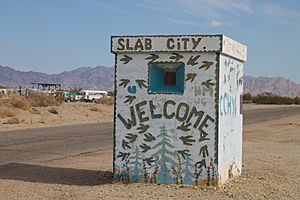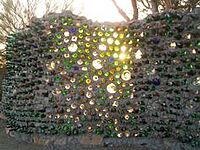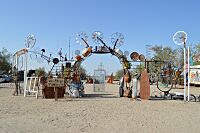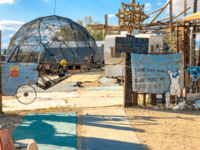Slab City, California facts for kids
Quick facts for kids Slab City |
|
|---|---|

The Second Guardshack, originally installed as a security measure by the United States Marine Corps, now painted with a sign welcoming visitors to Slab City.
|
|
| Location | Sonoran Desert, California (4 miles northeast of Niland) |
| Coordinates | 33°15′27″N 115°27′45″W / 33.25750°N 115.46250°W |
| Established | 1942 |
| Slogan | “The last free place” |
Slab City, also known as The Slabs, is a unique community in the Sonoran Desert of California. It's a place where people live "off-the-grid", meaning they don't rely on public services like electricity or water from the government. Many people who live here are "snowbirds", who travel south for the winter.
Slab City got its name from the concrete slabs left behind after a World War II military training camp, Camp Dunlap, was taken down. It's famous for attracting people who want to live a different kind of life, away from typical society.
Contents
History of Slab City
How Camp Dunlap Became The Slabs
- 1942: Camp Dunlap is Built
- The United States Marine Corps built Camp Dunlap to train soldiers for combat during World War II.
- 1949: Military Activity Slows Down
- After the war, fewer military operations happened at Camp Dunlap. Only a small group of staff stayed.
- 1956: Camp Dunlap is Taken Apart
- All the buildings at Camp Dunlap were ordered to be removed. But the strong concrete slabs were left behind.
- 1961: Land Given to California
- The military decided they didn't need the land anymore. So, they gave it to the State of California. The state didn't ask for the slabs to be removed.
- Later, a law was made that any money earned from this land would go to the California State Teachers Retirement System.
Early Settlers at The Slabs
- Harvesting Creosote Leaves
- At one point, a company hired workers to collect creosote leaves near Niland.
- Some of these workers moved their small trailers closer to the abandoned Camp Dunlap. This was the very beginning of what became Slab City.
- 1965: People Move to Slab City
- Many people were asked to leave a camping area near Mecca. These campers lived in all sorts of homes, like trailers, shacks made of cardboard, and old school buses.
- Some of these people moved to the abandoned Marine Training Base, which is now known as Slab City.
Where is Slab City?
Slab City is located on about 640 acres of public land. It's found near the eastern shore of the Salton Sea. The community is about 100 miles northeast of San Diego and 169 miles southeast of Los Angeles. It's also about 50 miles from the border with Mexico.
Slab City's Desert Weather
The area around Slab City gets a lot of sunshine all year. This is because of the stable air and high pressure in the region. Slab City has a hot desert climate, which means it's very warm and dry.
| Climate data for Niland (130 feet below sea level) | |||||||||||||
|---|---|---|---|---|---|---|---|---|---|---|---|---|---|
| Month | Jan | Feb | Mar | Apr | May | Jun | Jul | Aug | Sep | Oct | Nov | Dec | Year |
| Record high °F (°C) | 89 (32) |
97 (36) |
104 (40) |
108 (42) |
116 (47) |
121 (49) |
122 (50) |
120 (49) |
121 (49) |
111 (44) |
100 (38) |
93 (34) |
122 (50) |
| Mean daily maximum °F (°C) | 71 (22) |
74 (23) |
80 (27) |
86 (30) |
95 (35) |
103 (39) |
107 (42) |
107 (42) |
102 (39) |
91 (33) |
79 (26) |
70 (21) |
89 (32) |
| Daily mean °F (°C) | 56 (13) |
59 (15) |
64.5 (18.1) |
70 (21) |
77.5 (25.3) |
85 (29) |
91 (33) |
92 (33) |
86 (30) |
75 (24) |
63.5 (17.5) |
55 (13) |
72.9 (22.7) |
| Mean daily minimum °F (°C) | 41 (5) |
44 (7) |
49 (9) |
54 (12) |
60 (16) |
67 (19) |
75 (24) |
77 (25) |
70 (21) |
59 (15) |
48 (9) |
40 (4) |
57 (14) |
| Record low °F (°C) | 19 (−7) |
25 (−4) |
28 (−2) |
35 (2) |
40 (4) |
27 (−3) |
55 (13) |
59 (15) |
50 (10) |
30 (−1) |
11 (−12) |
22 (−6) |
11 (−12) |
| Average precipitation inches (mm) | 0.48 (12) |
0.55 (14) |
0.33 (8.4) |
0.05 (1.3) |
0.02 (0.51) |
0.00 (0.00) |
0.08 (2.0) |
0.21 (5.3) |
0.16 (4.1) |
0.25 (6.4) |
0.19 (4.8) |
0.48 (12) |
2.8 (70.81) |
| Source: Weather Channel | |||||||||||||
Who Lives in Slab City?
The number of people in Slab City changes with the seasons. In winter, the population can grow to about 4,000 people. Many "snowbirds" come to escape the cold weather elsewhere. In the hot summer, the population shrinks to about 150 permanent residents.
Since the 1950s, Slab City has attracted many different kinds of people. These include artists, creative thinkers, people who like to live freely, and retirees. It's a popular winter spot for travelers and people who live in RVs. Some residents are from Canada too!
How People Live in Slab City
Many residents use generators or solar panels to get electricity. Clean water is available from a tank at the community church. The closest town for shopping and supplies is Niland, about 4 miles away. Residents often go there for their basic needs.
During the 2020 COVID-19 pandemic, tourism to Slab City slowed down. This affected the community's income, as well as their access to food and water, which sometimes came from tourist donations.
Arts and Culture in Slab City
Slab City is known for its unique art and culture. It has a free library where you can borrow books. There's also an outdoor music spot called The Range. You can find an internet cafe, a hostel, and even a skatepark built inside an old military swimming pool.
Salvation Mountain: A Colorful Landmark
Right at the entrance to Slab City, you'll see the amazing Salvation Mountain. It's a large hill, about three stories tall, covered in colorful paint, concrete, and adobe. It's decorated with messages from the Bible.
- Built by Leonard Knight
- This incredible artwork was created over two decades by a Slab City resident named Leonard Knight.
- It's a 50-foot-tall piece of religious folk art. Many people see it as a main symbol of the community's creative and free spirit.
- A National Treasure
- In 2002, Salvation Mountain was officially recognized as a Congressional National Folk-Art Treasure.
- Rebuilding the Mountain
- The current Salvation Mountain is actually the second one Knight built. He started the first in 1984, but it collapsed in 1989.
- Knight didn't give up! He rebuilt it using stronger materials and better building methods.
- Leonard Knight passed away in 2014.
East Jesus: An Outdoor Art Gallery
East Jesus is an experimental art space in Slab City. The name means "a place in the middle of nowhere." It's an "off-grid" facility, meaning it doesn't use city power or water.
- How it Started
- In 2007, a man named Charlie Russell, also known as Container Charlie, moved his belongings to a trash-filled field. He started making sculptures around his cars. This became East Jesus.
- Charlie Russell passed away in 2011.
- Growing the Art
- After his death, a non-profit group called the Chasterus Foundation was formed. They now help manage and expand East Jesus.
- East Jesus features many kinds of experimental art. This includes live performances, music, photography, and especially sculptures.
- The artworks are always changing. They can decay in the desert heat or grow as new pieces are added by many different artists.
The Range: Slab City's Nightclub
The Range is an outdoor nightclub in Slab City. It has a stage, lights, and speakers. There are old couches and chairs for people to sit on.
- Saturday Night Talent Show
- Every Saturday night, locals and visitors gather for a talent show. Musicians who live there often perform, and anyone else who wants to share their talent can get on stage.
- Run by "Builder Bill"
- The Range is run by a long-time resident named William Ammon, known as "Builder Bill."
- His wife, Robin Ammon, collects old prom dresses. The community uses these dresses when they put on a "prom" for residents who never got to go to one.
Life in the Slab City Community
Slab City has different areas, each with its own feel. In 2020, it was mostly divided into East Jesus and Slab City itself. Thousands of campers and RV owners, many of them retired, visit during the winter. These "snowbirds" leave in the spring for cooler places.
Even with the very hot temperatures, about 150 people live in Slab City all year. These "Slabbers" or "Year-Rounders" find ways to live off the grid. Some get financial help from the government. Others choose to live there to learn how to be self-sufficient or to be away from busy city life.
The community has places like The Range, a library, and an internet cafe. Some places sell food, but most people go to Niland for their main shopping. Residents have even used CB radios to share messages and news.
During the COVID-19 pandemic, the community faced challenges. Less tourism meant less income and fewer donations for food and water. It was also hard to practice Social distancing because many residents work closely together. The community worried about the health of its older residents, especially since the nearest hospital is 40 minutes away.
What's Next for Slab City?
There are different ideas about who owns the land Slab City is on. Some reports say the State of California owns it. In 2021, California was thinking about selling the land. They also considered cleaning up any old military waste from the 1950s.
In 2015, some residents formed the Slab City Community Group. They wanted to prevent the land from being sold. They explored the idea of getting 450 acres of Slab City into a special trust.
In 2020, it was confirmed that the state still hoped to sell the land. Many residents are worried that if the land is sold, they might lose their community and their homes. Slab City has become a last resort for many people seeking a different way of life.
Images for kids









